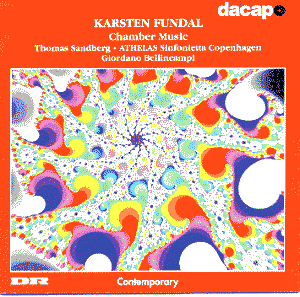The boxed biographical panel on the back of this Dacapo
disc notes Karsten Fundalís teachers; Hans Abrahamsen and Ib Nørholm.
He also took a course given by Morton Feldman at Dartington Hall and
studied with Louis Andriessen. Fundal has risen to prominence since
his mid-twenties after much thought, experimentation and synthesis Ė
his interests run from Keith Jarrett to Xenakis. Anders Beyerís sleevenotes
on the man Ė Thomas Michelsen writes on the music Ė make much of the
composerís desire to find a system (itís termed a feedback, or dynamic,
system) Ė but I listened to Fundalís compositions in the context of
form and instrumentation, rhythm and colour.
The compositions on this disc span much of the last
decade, a decade in which Fundal found his appropriate system (which
happened during studies in Aarhus). Zoom, which was composed
in 1997, opens with a determined piano and is full of mysterious and
characterful writing. Fundal is meticulous over dynamic and rhythmic
increments and includes some fine interjectory writing for percussion
and brass Ė some of which take on the incipient heroism of a chorale
(ultimately and mysteriously unresolved) and mark the high point of
the workís drama, of "zooming" in and across the palette of
the work (hence the title). The Wings of a Butterfly makes verbal
reference to Chaos Theory and takes the idea of increasing outward complexity
to a new level. There is indeed after the initial violin and accordion
unison introduction a constant and ceaseless developmental motion, shifting
sonorities between the four instruments (clarinet and viola in addition
to the two mentioned). This creates new patterns, in terms of sonority
and colour (I especially liked the way Fundal exploits the clarinetís
lower register, giving it an insistent and percussive profile). The
descending motifs in Traces come in varied patterns, some slow
and dreamy, but once more Fundalís clarinet can be a relatively combustible
protagonist, adding colour and drive. Fundal also extracts some spectral
sonorities from his quartet, slows to take in mordancy and a withdrawn
episode before a calming lento conclusion.
The Ways of Lightness and Falling is
the earliest of these works, dating as it does from 1991. Itís a clarinet
trio, lasting some twelve minutes and probably the uneasiest work here.
Opening shrilly, flecked with violent outbursts and piano clusters with
the clarinet at the top of its register, itís by no means an uncomplicated
listen. The cello reaches ever more uncomfortably higher in the register,
and the slow burgeoning sense of stasis that develops is never conciliatory,
but is always consumed with fear, before brutally interrupted by the
piano, which seems to assert itself primus inter pares as the
work develops. As the work concludes though itís the cello that ascends
once more, quietly and decisively and ends the work in mystifying abstraction.
The Two Simple Movements of 1995-96 are excellent examples of
Fundalís rhythmic interests Ė and the use to which patterns and rhythmic
displacements can be put. Finally Ritornello al contrario,
which is a percussion concerto in all but name. In the first movement
the soloist, Thomas Sandberg, uses everything from wood to metal, whilst
in the slow movement ("calmo") little gentle flecks charmingly
insinuate themselves into the line until toward the end of the movement,
preparing for the boisterous finale, the music becomes ever more military
and strong willed. Plenty of colour and motion here although I must
say I prefer Fundal in more concentrated, intricate forms.
Splendid production values from Dacapo and fine notes.
Jonathan Woolf
